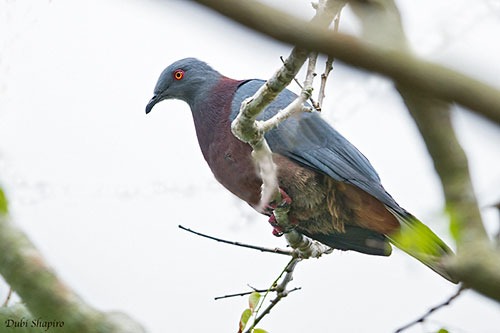
Male and female are similar, but the female is slightly smaller than male, with less brightly coloured plumage.
The juvenile is duller and without any gloss. Back and wing feathers have narrow rufous fringes.
RANGE:
The Vanuatu Imperial Pigeon is found in Banks Islands (Ureparapara, Vanua Lava and Gaua) and in N Vanuatu on Espíritu Santo, Ambae, Maewo, Pentecost and Ambrym.
HABITAT:
The Vanuatu Imperial Pigeon frequents hill and primary montane rainforest, from sea-level in banks islands, but above on larger islands, from 300 metres to the highest elevations.
CALLS AND SONGS: SOUNDS BY XENO-CANTO
The Vanuatu Imperial Pigeon utters series of 1-5 powerful, booming notes “hoow-hoow-hoow…” repeated at irregular intervals. The first note is drawn-out, but the following notes are all on the same pitch and rapidly delivered. This far-carrying call is a characteristic sound of the N Vanuatu mountains.
We can also hear an occasional deep purring “br-r-r-r-r”.
BEHAVIOUR IN THE WILD:
The Vanuatu Imperial Pigeon is frugivorous. It feeds on fleshy fruit and berries of various native trees, shrubs, vines and probably palms.
It forages mainly in the canopy, but also in the lower parts of the forest, and even occasionally close to the ground in low, fruiting shrubs.
The Vanuatu Imperial Pigeon is shy and very retiring, more often heard than seen. It is usually alone or in pairs, but small groups of 5-6 individuals may gather at fruiting trees. The seeds of the fruits are dispersed through the forest by the droppings.
Nothing is known about the breeding habits. However, the breeding behaviour is probably typical of Columbidae.
The Vanuatu Imperial Pigeon is partially nomadic and may sometimes perform long-distance flights within the larger islands while searching for food, and especially fruiting trees.
The flight is powerful, fast and direct, with slow, deep, deliberate wingbeats.
REPRODUCTION OF THIS SPECIES:
Information is currently lacking. In Vanuatu, most nests can be found in September and January, and some others in July and August.
The nest is a typical flimsy platform made with twigs and some leaves. It is placed on horizontal branch in tree.
The clutch contains 1-2 eggs and both parents share the nesting duties.
PROTECTION / THREATS / STATUS:
The Vanuatu Imperial Pigeon is threatened by hunting between April and June, but habitat loss also affects the species. The clearance of forest for agriculture expansion in mid-montane areas, and degradation of lowland forest by logging and cattle-ranching are important threats too.
The population is roughly estimated to number 3,500/15,000 individuals and is slowly declining.
The Vanuatu Imperial Pigeon is currently listed as Vulnerable.
Fr: Carpophage de Baker
Ang: Vanuatu Imperial-Pigeon - Baker's Imperial-Pigeon
All: Kurzflügel-Fruchttaube
Esp: Dúcula de Nuevas Hébridas
Ita: Piccione imperiale di Baker
Nd: Bakers Muskaatduif
Sd: vanuatukejsarduva
Photographer:
Dubi Shapiro
Dubi Shapiro Photo Galleries & Dubi Shapiro's Pictures on IBC
Text by Nicole Bouglouan
Sources:
HANDBOOK OF THE BIRDS OF THE WORLD vol 4 by Josep del Hoyo-Andrew Elliott-Jordi Sargatal - Lynx Edicions - ISBN: 8487334229
PIGEONS AND DOVES by David Gibbs, Eustace Barnes and John Cox - Pica Press Sussex - ISBN: 1873403607
Birds of Melanesia: Bismarcks, Solomons, Vanuatu and New Caledonia Par Guy Dutson – Editeur : Bloomsbury Publishing, 2011 – ISBN: 1408152460, 9781408152461
Avibase (Denis Lepage)
Wikipedia, the free encyclopaedia
VESS – Vanuatu Environmental Science Society
Vanuatu Imperial Pigeon or Baker’s Imperial Pigeon
Ducula bakeri
Columbiformes Order – Columbidae Family
INTRODUCTION:
The Vanuatu Imperial Pigeon or Baker’s Imperial Pigeon is endemic to Vanuatu. It occurs on several larger islands where it frequents the primary montane forest from lowlands to high elevations. It feeds on fruit and berries from various native trees and other plants.
The Vanuatu Imperial Pigeon or Baker’s Imperial Pigeon is threatened by hunting and degradation of forests. The species is currently listed as Vulnerable.
Its name pays tribute to the British zoologist John Randal Baker who discovered this species.
DESCRIPTION OF THE BIRD:
Biometrics:
Length: 40 cm
The Vanuatu Imperial Pigeon has dark slate-grey mantle, wings and tail, whereas collar, back and breast are dark chestnut with indistinct purplish gloss.
The belly is rufous brown to deep chestnut, and undertail-coverts are paler rufous. On the underwings, the coverts are chestnut while the flight feathers are slightly paler rufous.
The head is sooty blue-grey with paler chin, throat and forehead.
The bill is black. The eyes are bright yellow with bright red outer ring. Legs and feet are pinkish-red.
